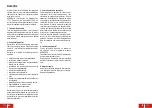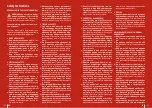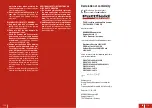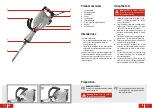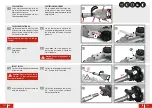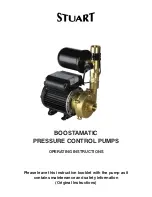
EN
116
EN
117
Safety Instructions
GENERAL POWER TOOL SAFETY WARNINGS
WARNING Read all safety warnings
and all instructions.
Failure to follow
the warnings and instructions may result in
electric shock, fire and/or serious injury.
Save all warnings and instructions for fu-
ture reference.
The term “power tool“ in the warnings refers
to your mains-operated (corded) power tool or
battery-operated (cordless) power tool.
1 WORK AREA SAFETY
a)
Keep work area clean and well lit.
Clut-
tered or dark areas invite accidents.
b)
Do not operate power tools in explosive
atmospheres, such as in the presence of
flammable liquids, gases or dust.
Power
tools create sparks which may ignite the
dust or fumes.
c)
Keep children and bystanders away
while operating a power tool.
Distractions
can cause you to lose control.
2 ELECTRICAL SAFETY
a)
Power tool plugs must match the outlet.
Never modify the plug in any way. Do
not use any adapter plugs with earthed
(grounded) power tools.
Unmodified plugs
and matching outlets will reduce risk of
electric shock.
b)
Avoid body contact with earthed or
grounded surfaces, such as pipes, ra-
diators, ranges and refrigerators.
There
is an increased risk of electric shock if your
body is earthed or grounded.
c)
Do not expose power tools to rain or wet
conditions.
Water entering a power tool will
increase the risk of electric shock.
d)
Do not abuse the cord. Never use the
cord for carrying, pulling or unplugging
the power tool. Keep cord away from
heat, oil, sharp edges or moving parts.
Damaged or entangled cords increase the
risk of electric shock.
e)
When operating a power tool outdoors,
use an extension cord suitable for out-
door use.
Use of a cord suitable for outdoor
use reduces the risk of electric shock.
f)
If operating a power tool in a damp loca-
tion is unavoidable, use a residual cur-
rent device (RCD) protected supply.
Use
of an RCD reduces the risk of electric shock.
3 PERSONAL SAFETY
a)
Stay alert, watch what you are doing
and use common sense when operating
a power tool. Do not use a power tool
while you are tired or under the influ-
ence of drugs, alcohol or medication.
A moment of inattention while operating
power tools may result in serious personal
injury.
b)
Use personal protective equipment. Al-
ways wear eye protection.
Protective
equipment such as dust mask, non-skid
safety shoes, hard hat, or hearing protec-
tion used for appropriate conditions will re-
duce personal injuries.
c)
Prevent unintentional starting. Ensure
the switch is in the off-position before
connecting to power source and/or bat-
tery pack, picking up or carrying the
tool.
Carrying power tools with your finger
on the switch or energising power tools that
have the switch on invites accidents.
d)
Remove any adjusting key or wrench be-
fore turning the power tool on.
A wrench
or a key left attached to a rotating part of
the power tool may result in personal injury.
e)
Do not overreach. Keep proper footing
and balance at all times.
This enables
better control of the power tool in unexpect-
ed situations.
f)
Dress properly. Do not wear loose cloth-
ing or jewellery. Keep your hair, cloth-
ing and gloves away from moving parts.
Loose clothes, jewellery or long hair can be
caught in moving parts.
g)
If devices are provided for the connec-
tion of dust extraction and collection fa-
cilities, ensure these are connected and
properly used.
Use of dust collection can
reduce dust-related hazards.
h)
Do not let familiarity gained from fre-
quent use of tools allow you to become
complacent and ignore tool safety prin-
ciples.
A careless action can cause severe
injury within a fraction of a second.
4 POWER TOOL USE AND CARE
a)
Do not force the power tool. Use the cor-
rect power tool for your application.
The
correct power tool will do the job better and
safer at the rate for which it was designed.
b)
Do not use the power tool if the switch
does not turn it on and off.
Any power tool
that cannot be controlled with the switch is
dangerous and must be repaired.
c)
Disconnect the plug from the power
source and/or the battery pack from the
power tool before making any adjust-
ments, changing accessories, or storing
power tools.
Such preventive safety meas-
ures reduce the risk of starting the power
tool accidentally.
d)
Store idle power tools out of the reach
of children and do not allow persons
unfamiliar with the power tool or these
instructions to operate the power tool.
Power tools are dangerous in the hands of
untrained users.
e)
Maintain power tools. Check for mis-
alignment or binding of moving parts,
breakage of parts and any other condi-
tion that may affect the power tool’s op-
eration. If damaged, have the power tool
repaired before use.
Many accidents are
caused by poorly maintained power tools.
f)
Keep cutting tools sharp and clean.
Properly maintained cutting tools with sharp
cutting edges are less likely to bind and are
easier to control.
g)
Use the power tool, accessories and
tool bits etc. in accordance with these
instructions, taking into account the
working conditions and the work to be
performed.
Use of the power tool for op-
erations different from those intended could
result in a hazardous situation.
h)
Keep handles and grasping surfaces dry,
clean and free from oil and grease.
Slip-
pery handles and grasping surfaces do not
allow for safe handling and control of the
tool in unexpected situations.
5 SERVICE
a)
Have your power tool serviced by a qual-
ified repair person using only identical
replacement parts.
This will ensure that
the safety of the power tool is maintained.
b)
Never service damaged battery packs.
Service of battery packs should only be per-
formed by the manufacturer or authorized
service providers.
MACHINE SPECIFIC SAFETY WARNINGS
FOR HAMMER
a)
Wear ear protectors when impact drill-
ing.
Exposure to noise can cause hearing
loss.
b)
Use auxiliary handle(s), if supplied with
the tool.
Loss of control can cause personal
injury.
c)
Hold power tool by insulated gripping
surfaces, when performing an operation
where the cutting accessory may con-
tact hidden wiring or its own cord.
Cut-
ting accessory contacting a “live” wire may
make exposed metal parts of the power tool
“live” and could give the operator an electric
shock.
d)
Use a metal detector to determine if
there are gas or water pipes hidden in
the work area or call the local utility
company for assistance before begin-
ning the operation.
Striking or cutting into
a gas line will result in explosion. Water en-
tering an electrical device may cause elec-
trocution.
a)
Hold the tool safely with both hands dur-
ing working and have a safe standing.
Make sure to keep a straight posture
during working.
b)
Never place the tool down until the chis-
el or accessory has come to a complete
stop. Do not use dull or damaged chisels
and accessories. Dull or damaged chis-
els have a greater tendency to bind in
the workpiece.
c)
When removing the chisel from the tool
avoid contact with skin and use proper













